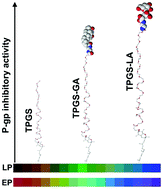当前位置:
X-MOL 学术
›
Polym. Chem.
›
论文详情
Our official English website, www.x-mol.net, welcomes your feedback! (Note: you will need to create a separate account there.)
Mechanisms of TPGS and its derivatives inhibiting P-glycoprotein efflux pump and application for reversing multidrug resistance in hepatocellular carcinoma†
Polymer Chemistry ( IF 4.6 ) Pub Date : 2018-03-05 00:00:00 , DOI: 10.1039/c8py00344k Tengfei Liu 1, 2, 3, 4, 5 , Xiaoyan Liu 1, 2, 3, 4, 5 , Hui Xiong 1, 2, 3, 4, 5 , Cheng Xu 1, 2, 3, 4, 5 , Jianxu Yao 1, 2, 3, 4, 5 , Xiumei Zhu 1, 2, 3, 4, 5 , Jianping Zhou 1, 2, 3, 4, 5 , Jing Yao 1, 2, 3, 4, 5
Polymer Chemistry ( IF 4.6 ) Pub Date : 2018-03-05 00:00:00 , DOI: 10.1039/c8py00344k Tengfei Liu 1, 2, 3, 4, 5 , Xiaoyan Liu 1, 2, 3, 4, 5 , Hui Xiong 1, 2, 3, 4, 5 , Cheng Xu 1, 2, 3, 4, 5 , Jianxu Yao 1, 2, 3, 4, 5 , Xiumei Zhu 1, 2, 3, 4, 5 , Jianping Zhou 1, 2, 3, 4, 5 , Jing Yao 1, 2, 3, 4, 5
Affiliation

|
D-α-Tocopheryl polyethylene glycol 1000 succinate (TPGS) and TPGS based conjugates have been widely researched for treatment of multidrug-resistant (MDR) cancer. Nevertheless, the influence of structural modification of TPGS on its properties and function requires further exploration. In this study, a hypothesis for the interaction between TPGS and P-glycoprotein (P-gp) at the molecular level has been proposed based on the existing limited knowledge of TPGS inhibition on P-gp. Two TPGS derivatives, TPGS–glycyrrhetinic acid conjugate (TGA) and TPGS–lactobionic acid conjugate (TLA), were synthesized. Molecular docking and molecular dynamics (MD) simulations were employed to investigate the P-gp inhibitory ability of TPGS and its derivatives and their inhibitory mechanism. Moreover, a systematic in vitro experiment was conducted to further confirm simulation results and evaluate antitumor effects. It was found that TLA and TGA displayed higher binding affinities with P-gp than TPGS, which was attributed to their properties of hydrophilicity and negative charge. Meanwhile, TPGS and its derivatives prevented the P-gp ATPase from hydrolyzing ATP by blocking the ATP binding sites, thereby inhibiting P-gp function. It was also found that the high hydrophilic–lipophilic balance (HLB) of the polymer contributed to a significant MDR reversing effect. In addition, TLA and TGA could promote intercellular accumulation and noticeably enhance the cytotoxicity of DOX in HepG2 and HepG2/ADR cells compared to TPGS. This work may be an important step in understanding the structure–activity relationships (SARs) of TPGS and its derivatives, the roles of the three polymers in MDR reversal mechanisms and in designing promising excipients for reversing MDR. The results suggested that TLA and TGA can be used as potential P-gp inhibitors or nanocarriers in the field of drug delivery.
中文翻译:

TPGS及其衍生物抑制P-糖蛋白外排泵的机制及其在逆转肝癌多药耐药性中的应用†
D -α-生育酚聚乙二醇1000琥珀酸酯(TPGS)和基于TPGS的结合物已被广泛研究用于治疗多药耐药(MDR)癌症。然而,TPGS的结构修饰对其性能和功能的影响尚需进一步探索。在这项研究中,基于对TPGS抑制P-gp的现有有限知识,提出了TPGS与P-糖蛋白(P-gp)在分子水平上相互作用的假说。合成了两种TPGS衍生物,即TPGS-甘草次酸共轭物(TGA)和TPGS-内苯二酸共轭物(TLA)。分子对接和分子动力学(MD)模拟用于研究TPGS及其衍生物的P-gp抑制能力及其抑制机理。而且,系统的体外进行实验以进一步证实模拟结果并评估抗肿瘤作用。发现TLA和TGA与P-gp的结合亲和力比TPGS高,这归因于它们的亲水性和负电荷特性。同时,TPGS及其衍生物通过阻断ATP结合位点而阻止了P-gp ATP酶水解ATP,从而抑制了P-gp功能。还发现该聚合物的高亲水亲脂平衡(HLB)有助于显着的MDR逆转作用。此外,与TPGS相比,TLA和TGA可以促进细胞间积累,并显着增强DOX在HepG2和HepG2 / ADR细胞中的细胞毒性。这项工作可能是理解TPGS及其衍生物的构效关系(SAR)的重要一步,三种聚合物在MDR逆转机制中的作用以及在设计有希望的MDR逆转赋形剂中的作用。结果表明,TLA和TGA可以用作潜在的P-gp抑制剂或药物输送领域中的纳米载体。
更新日期:2018-03-05
中文翻译:

TPGS及其衍生物抑制P-糖蛋白外排泵的机制及其在逆转肝癌多药耐药性中的应用†
D -α-生育酚聚乙二醇1000琥珀酸酯(TPGS)和基于TPGS的结合物已被广泛研究用于治疗多药耐药(MDR)癌症。然而,TPGS的结构修饰对其性能和功能的影响尚需进一步探索。在这项研究中,基于对TPGS抑制P-gp的现有有限知识,提出了TPGS与P-糖蛋白(P-gp)在分子水平上相互作用的假说。合成了两种TPGS衍生物,即TPGS-甘草次酸共轭物(TGA)和TPGS-内苯二酸共轭物(TLA)。分子对接和分子动力学(MD)模拟用于研究TPGS及其衍生物的P-gp抑制能力及其抑制机理。而且,系统的体外进行实验以进一步证实模拟结果并评估抗肿瘤作用。发现TLA和TGA与P-gp的结合亲和力比TPGS高,这归因于它们的亲水性和负电荷特性。同时,TPGS及其衍生物通过阻断ATP结合位点而阻止了P-gp ATP酶水解ATP,从而抑制了P-gp功能。还发现该聚合物的高亲水亲脂平衡(HLB)有助于显着的MDR逆转作用。此外,与TPGS相比,TLA和TGA可以促进细胞间积累,并显着增强DOX在HepG2和HepG2 / ADR细胞中的细胞毒性。这项工作可能是理解TPGS及其衍生物的构效关系(SAR)的重要一步,三种聚合物在MDR逆转机制中的作用以及在设计有希望的MDR逆转赋形剂中的作用。结果表明,TLA和TGA可以用作潜在的P-gp抑制剂或药物输送领域中的纳米载体。


























 京公网安备 11010802027423号
京公网安备 11010802027423号